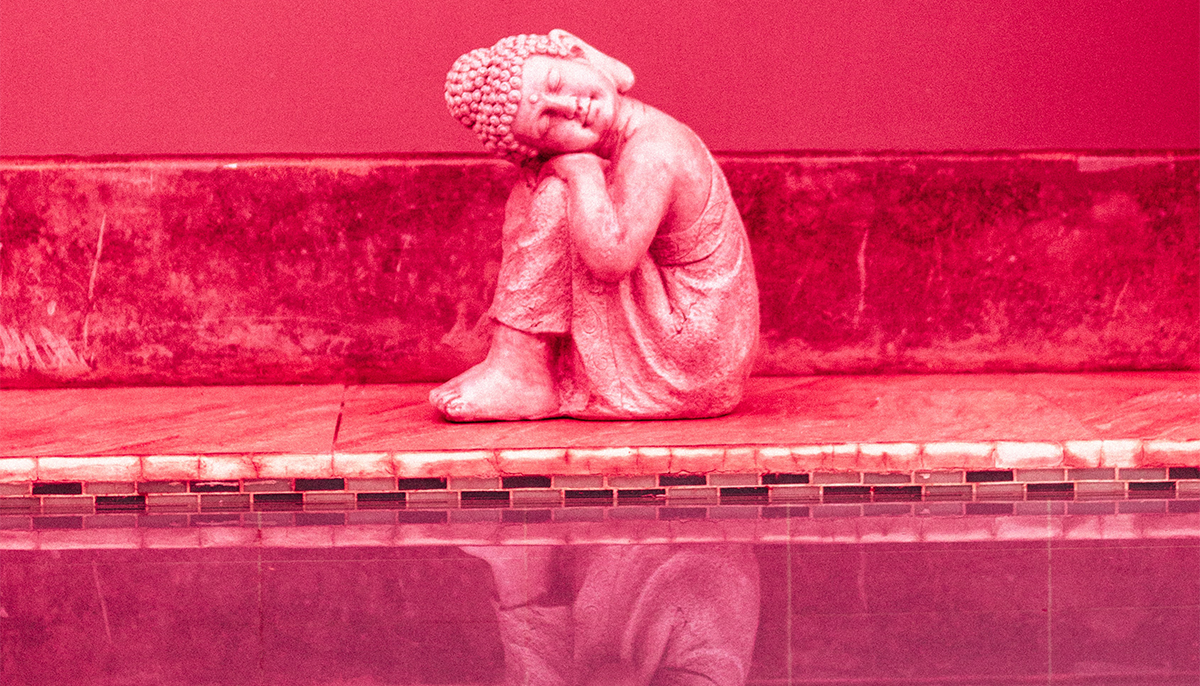The first stage in the practice of tonglen, or taking and sending, is a pause, a moment of stillness and space, a brief gap. If you need an image for this, you can reflect on any experience of wide-open space, such as gazing out at the ocean or looking up into a cloudless sky.
The second stage is a visualization, working with texture. As you inhale, breathe in hot, heavy, thick energy—a feeling of claustrophobia. breathe it in completely, through all the pores of your body. Then, as you exhale, breathe out a sense of freshness, of cool, light, bright energy. radiate it outward 360 degrees. Continue for a few minutes, or until the imagery is in sync with the in and out breaths.
The third stage involves breathing in a specific painful situation, opening to it as fully as possible, then breathing out spaciousness and relief. Traditionally we begin tonglen for a person or animal we wish to help, but we can also begin with our personal experience in the moment—a feeling of hopelessness or anger, for example—and use that as a stepping-stone for connecting us with the painful feelings of others.
We can breathe out flexibility, lightheartedness, nonaggression, strength—whatever we feel will bring comfort and upliftedness and relief.
In the fourth stage, we extend tonglen further. If we’re doing it for a friend with AIDS, we extend it to all of those with AIDS. If we’re doing it for our alcoholic sister, we extend it to all alcoholics, to all of those suffering from addiction. If we’re already doing tonglen for all of those experiencing the same pain we are, we can extend it to all of those, all over the world, who are suffering in any way, mentally or physically. And we can extend it still further to include all of us caught up in self-absorption, all of us tormented by our fixated minds and our inability to let go of hope and fear.
As a general guideline, we start tonglen practice with a situation that is immediate and real, not something vague or impersonal. Then we extend it to include more and more beings who are suffering in a similar way, as well as all of us suffering from ego clinging, all of us suffering from resistance to uncertainty and impermanence.
If we ourselves have had even a glimmer of what egolessness feels like, of what awakening feels like, of what freedom feels like, then we want that for others too. When we see that they’re hooked, instead of being critical and judgmental, we can empathize with what they’re going through—we’ve been there and know exactly how they feel. Our wish for other people is the same as our wish for ourselves: to appreciate ourselves, to recognize when we’re caught and disentangle ourselves from those feelings, to stop reinforcing the dysfunctional patterns that prolong our suffering, to reach out to others, to experience the goodness of being human.
Whether we do tonglen as a formal practice or on the spot, does it take time to get used to? Yes, it does. Does it take getting accustomed to the rawness of pain? Does it take patience and gentleness? Yes, it does. There’s no need to get discouraged when the practice seems too hard.
Allow yourself to ease into it slowly and at your own pace, working first with situations that are easy for you right now. I always remember what my teacher used to say when i was losing my confidence and wanted to give up. He’d sit up tall and smile broadly and proclaim, “You can do it!” Somehow his confidence was contagious, and when I heard those words, I knew I could.
I once read a poem about practicing tonglen in a time of war. The imagery was of breathing in bombs falling, violence, despair, losing your legs and coming home with your face burned and disfigured, and then sending out the beauty of the earth and sky, the goodness of people, safety and peace. In the same spirit, we can breathe in hatred and jealousy, envy and addiction—all the sorrow of the human drama—using our personal experience of that pain and extending tonglen to all others caught in the same way. Then we can breathe out flexibility, lightheartedness, nonaggression, strength—whatever we feel will bring comfort and upliftedness and relief. the pain of the world pierces us to the heart, but we never forget the goodness of being alive.
The time has come for us to try the opposite approach: to take in the bad and give out the good. Compassion is not a matter of pity or the strong helping the weak; it’s a relationship between equals, one of mutual support. Practicing tonglen, we come to realize that other people’s welfare is just as important as our own. In helping them, we help ourselves. In helping ourselves, we help the world.
From Living Beautifully with Uncertainty and Change by Pema Chödrön © 2012 by Pema Chödrön. Reprinted in arrangement with Shambhala Publications, Inc. Boulder, CO.

